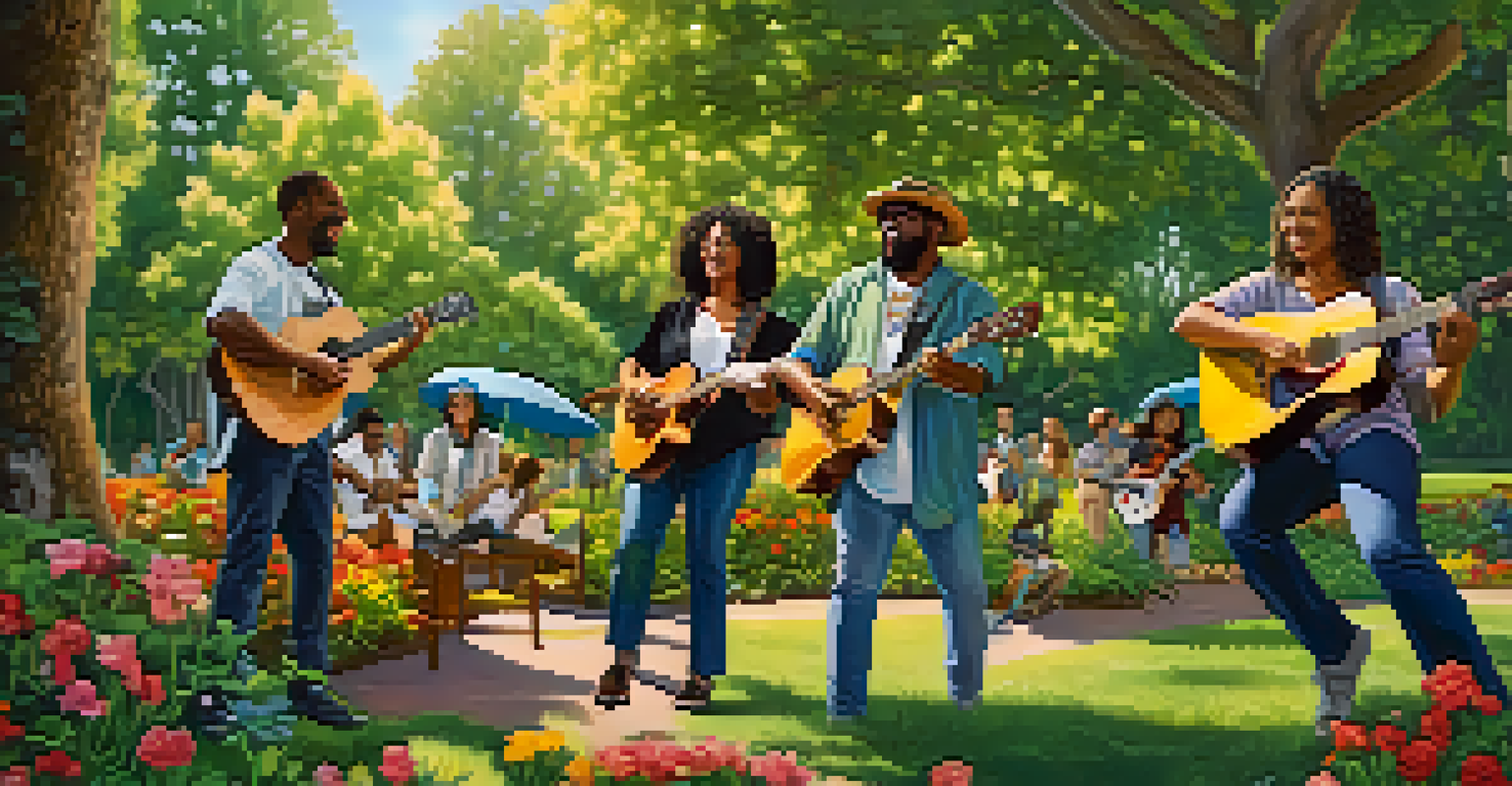Creating Engaging Online Guitar Courses for Passive Income

Identifying Your Target Audience for Guitar Courses
Before diving into course creation, it's crucial to know who you’re targeting. Are you aiming at beginners eager to strum their first chords or advanced players looking to refine their skills? Understanding your audience's needs will shape your content, ensuring it resonates with them and keeps them engaged.
The best way to predict the future is to create it.
You can consider creating profiles for different types of learners, such as teenagers wanting to play pop music or adults interested in jazz. This targeted approach allows you to tailor your teaching style and material accordingly, making your course more appealing. Remember, the more specific you are, the more likely you are to attract dedicated students.
Additionally, engaging with potential students through social media or forums can provide insights into their preferences. By asking questions and gathering feedback, you can fine-tune your course offerings, ensuring they meet the desires of your audience and stand out in a crowded market.
Choosing the Right Platform for Your Guitar Course
Selecting the right platform is essential for a smooth learning experience. Popular options include Udemy, Teachable, or even your own website. Each platform offers unique features, so consider what aligns best with your goals and audience needs.

For instance, if you want to build a community, platforms like Thinkific allow for interaction among students. Alternatively, if you're focused on video content, YouTube could serve as a great launching pad. Assessing your priorities will help you choose a platform that enhances your course's effectiveness.
Know Your Audience
Identifying your target audience ensures that your course content resonates with students and meets their specific needs.
Additionally, think about the pricing structures and revenue share models each platform offers. This financial aspect will impact your passive income potential, so make sure you choose wisely to maximize your earnings while providing value to your students.
Creating Compelling Course Content That Engages Students
Content is king, especially in online courses. Start by outlining your curriculum, ensuring it flows logically from one topic to the next. Engaging content includes a mix of video lessons, downloadable resources, and interactive quizzes to keep learners invested.
Content is fire, social media is gasoline.
To illustrate concepts, consider using real-life examples or anecdotes from your own guitar journey. This connection helps students relate to the material and see its practical application. Remember, the goal is to make learning enjoyable and memorable, not just informative.
Incorporating diverse teaching methods, such as step-by-step tutorials or jam-along tracks, can cater to different learning styles. By keeping the content varied and dynamic, you can maintain student interest and encourage them to progress through your course.
Utilizing Video Lessons Effectively in Your Guitar Course
Video lessons are a powerful tool in online guitar courses. They allow you to demonstrate techniques in real-time, which is invaluable for learners. When creating videos, focus on clarity: ensure your visuals are sharp and your audio is crisp, so students can easily follow along.
Consider breaking down complex techniques into bite-sized segments. This approach prevents students from feeling overwhelmed and allows them to grasp each concept at their own pace. Adding captions or visual aids can further enhance understanding and retention.
Choose the Right Platform
Selecting a suitable platform for your guitar course enhances the learning experience and aligns with your goals.
Don't forget to inject your personality into your videos! A friendly, approachable demeanor can make a world of difference in how students perceive you and your teaching. Being relatable helps build a connection, making students feel more comfortable and engaged.
Marketing Your Online Guitar Course to Attract Students
Once your course is ready, it's time to spread the word! Effective marketing strategies can include social media promotions, email newsletters, and collaborations with influencers in the music industry. Creating engaging content that showcases your expertise will help draw potential students in.
Consider offering free webinars or mini-courses as a taste of what you offer. This not only builds trust but also allows students to experience your teaching style firsthand. When they see the value in your content, they’re more likely to enroll in your full course.
Additionally, leveraging testimonials and success stories from previous students can significantly boost your credibility. Social proof is a powerful motivator, so don’t hesitate to showcase how your courses have helped others achieve their guitar-playing goals.
Building a Community Around Your Guitar Course
Creating a sense of community can greatly enhance the learning experience. Consider establishing a forum or a Facebook group where students can connect, share progress, and ask questions. This interaction fosters a supportive environment that encourages collaboration and motivation.
Regularly engaging with your community through live Q&A sessions or feedback surveys can also boost retention rates. When students feel like they are part of something larger, they're more likely to remain committed to their learning journey.
Engage with Compelling Content
Creating diverse and engaging course materials, including video lessons and interactive resources, keeps students invested in their learning.
Moreover, a vibrant community can lead to word-of-mouth referrals. Happy students are your best ambassadors, and their positive experiences can attract new learners looking for a welcoming and interactive learning space.
Monetizing Your Guitar Course for Passive Income
Once your course is live and gaining traction, it's time to focus on monetization strategies. Consider offering tiered pricing options, such as basic access or premium packages that include one-on-one coaching. This flexibility can cater to different budgets and increase your overall revenue.
You might also explore affiliate marketing, where you recommend products related to guitar playing and earn a commission on sales. This approach not only provides an additional income stream but also enriches your course content by offering valuable resources to your students.

Lastly, don’t forget about upselling opportunities. If students are enjoying your initial course, they may be interested in advanced lessons or specialized workshops. By providing pathways for continued learning, you can ensure a steady stream of passive income while helping students achieve their goals.